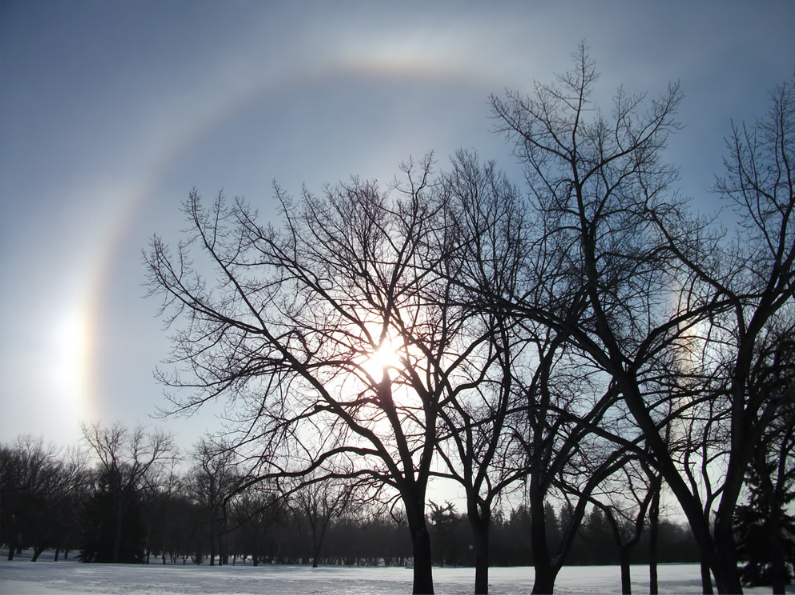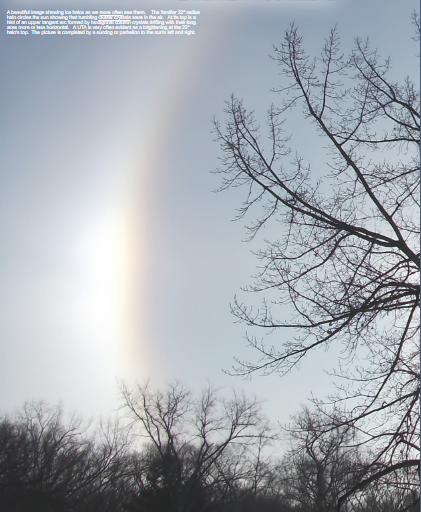OPOD - Saskatchewan Halos
OPOD - Saskatchewan Halos: A Mesmerizing Display of Atmospheric Optics
Atmospheric optics never cease to amaze us with their captivating beauty. One such spectacle is the mesmerizing display of Saskatchewan Halos, captured in a stunning image by Shelley Banks. In this article, we will delve into the enchanting world of ice halos and explore the intricate details of this particular phenomenon.
Unveiling the Wonders of Saskatchewan Halos
The focal point of Banks' image is the familiar 22° radius halo encircling the sun, indicating the presence of tumbling cluster crystals in the air. These tiny ice crystals, shaped like hexagonal prisms, interact with sunlight to create a halo that seems to embrace the celestial orb. The 22° halo is a common sight and forms due to the refraction and reflection of light within these ice crystals.
But the wonders don't stop there. At the top of the 22° halo, a faint yet discernible upper tangent arc (UTA) makes its appearance. This ethereal arc is formed by hexagonal column crystals drifting with their long axes more or less horizontal. The UTA often manifests as a brightening at the top of the 22° halo, adding an extra touch of splendor to the atmospheric display.
Completing this celestial masterpiece are sundogs or parhelia, which flank the sun on its left and right sides. Sundogs are created when sunlight interacts with plate-shaped ice crystals suspended in the atmosphere. These crystals act as tiny prisms, bending the light and producing vibrant patches of color that mimic miniature suns.
The Science Behind Saskatchewan Halos
To truly appreciate the beauty of Saskatchewan Halos, it's essential to understand the scientific principles at play. These atmospheric phenomena arise from the interaction between sunlight and ice crystals present in the atmosphere. The intricate geometry of these crystals determines the specific optical effects observed.
Here's a breakdown of the key elements contributing to the formation of Saskatchewan Halos:
- Tumbling cluster crystals: These small ice crystals tumble and rotate as they fall through the atmosphere, resulting in the formation of the 22° radius halo encircling the sun.
- Hexagonal column crystals: These elongated ice crystals drift with their long axes predominantly horizontal, creating the upper tangent arc (UTA) that appears above the 22° halo.
- Refraction and reflection: When sunlight enters an ice crystal, it undergoes refraction, bending the light rays. The bent rays then reflect off the inner surfaces of the crystal, leading to the formation of halos and arcs.
- Plate-shaped ice crystals: These crystals, suspended in the air, contribute to the creation of sundogs or parhelia. Sunlight passing through these crystals is refracted and dispersed, generating the vibrant patches of color seen alongside the sun.
Exploring the Awe-Inspiring World of Atmospheric Optics
Saskatchewan Halos provide us with a glimpse into the awe-inspiring world of atmospheric optics. While this particular phenomenon showcases the interplay between ice crystals and sunlight, there are numerous other optical effects that grace our skies. Some of these include:
- Circumzenithal arc: A vivid arc that appears above the sun, characterized by its vibrant colors and an upward-curving shape.
- Supralateral arc: An arc that forms above the sun and intersects with the 22° halo, resulting in a stunning visual display.
- Sun pillars: Vertical columns of light that appear above or below the sun, caused by the reflection of sunlight off ice crystals.
- Lunar halos: Similar to solar halos, lunar halos create luminous rings around the moon, enchanting observers with their ethereal glow.
Each atmospheric optics phenomenon has its own unique set of conditions and crystal formations, leading to the diverse array of captivating visuals we witness in the sky.
Embracing the Beauty of the Skies
Observing Saskatchewan Halos and other atmospheric optics phenomena is a reminder of the immense beauty that surrounds us. These natural wonders invite us to pause, look up, and appreciate the intricacies of our atmosphere. From the delicate interplay of light and ice crystals to the formation of mesmerizing arcs and halos, the skies offer us a glimpse into the marvels of nature.
So, next time you find yourself outdoors on a clear day, take a moment to gaze at the sky and immerse yourself in the enchanting world of atmospheric optics. Who knows what breathtaking display might be waiting just beyond the horizon?

Saskatchewan Halos Captured by Shelley Banks (site). Shelly Banks, shown with permission.
A beautiful image showing ice halos as we more often see them. The familiar 22° radius halo circles the sun showing that tumbling cluster crystals were in the air. At its top is a hint of an upper tangent arc formed by hexagonal column crystals drifting with their long axes more or less horizontal. A UTA is very often evident as a brightening at the 22° halo's top. The picture is completed by a sundog or parhelion to the sun's left and right.

Note: this article has been automatically converted from the old site and may not appear as intended. You can find the original article here.
Reference Atmospheric Optics
If you use any of the definitions, information, or data presented on Atmospheric Optics, please copy the link or reference below to properly credit us as the reference source. Thank you!
-
<a href="https://atoptics.co.uk/blog/opod-saskatchewan-halos/">OPOD - Saskatchewan Halos</a>
-
"OPOD - Saskatchewan Halos". Atmospheric Optics. Accessed on April 16, 2024. https://atoptics.co.uk/blog/opod-saskatchewan-halos/.
-
"OPOD - Saskatchewan Halos". Atmospheric Optics, https://atoptics.co.uk/blog/opod-saskatchewan-halos/. Accessed 16 April, 2024
-
OPOD - Saskatchewan Halos. Atmospheric Optics. Retrieved from https://atoptics.co.uk/blog/opod-saskatchewan-halos/.